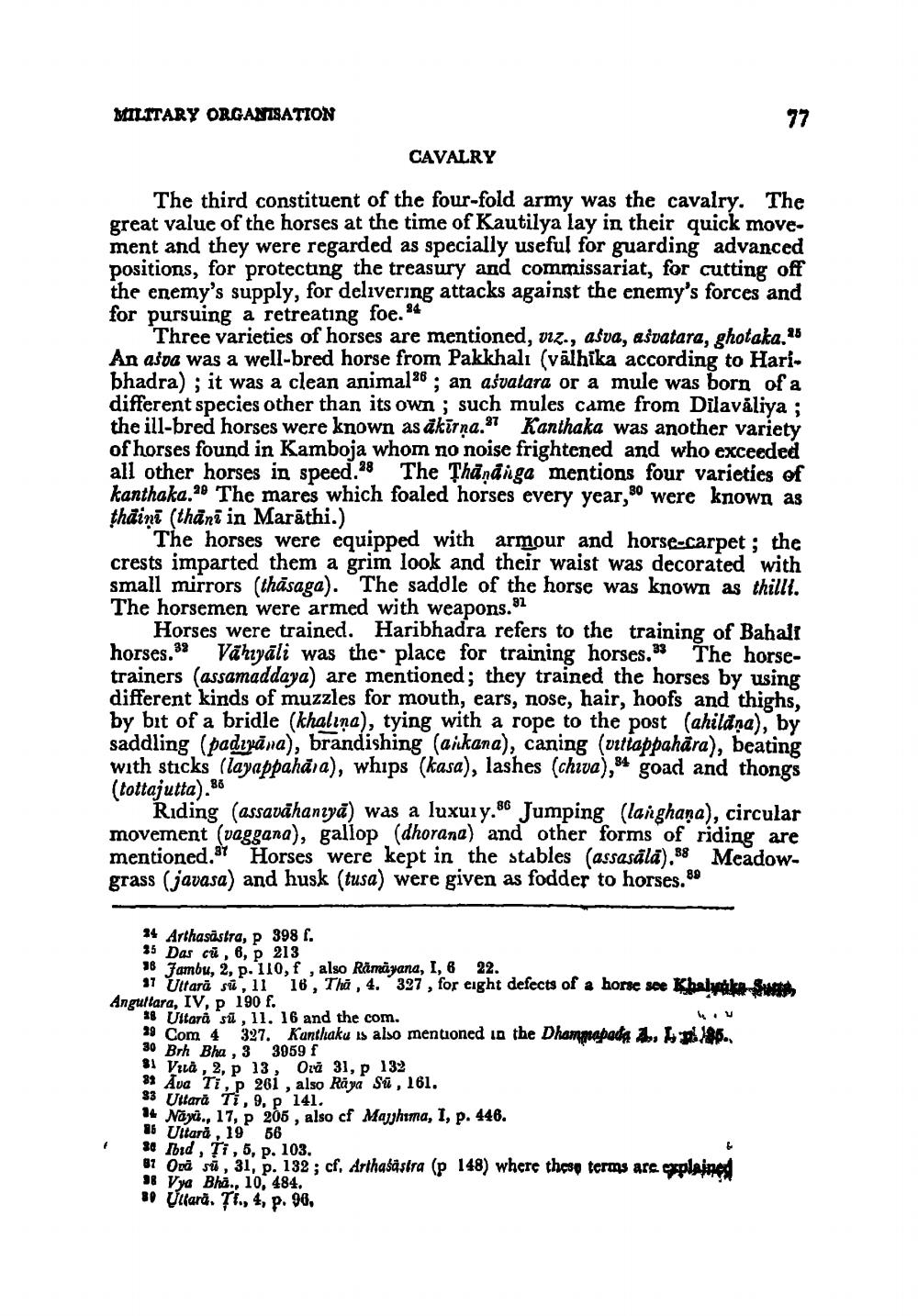________________
MILITARY ORGANISATION
CAVALRY
The third constituent of the four-fold army was the cavalry. The great value of the horses at the time of Kautilya lay in their quick movement and they were regarded as specially useful for guarding advanced positions, for protecting the treasury and commissariat, for cutting off the enemy's supply, for delivering attacks against the enemy's forces and for pursuing a retreating foe. 24
Three varieties of horses are mentioned, viz., asva, asvatara, ghotaka. 45 An asda was a well-bred horse from Pakkhalı (välhika according to Hari. bhadra); it was a clean animal26 ; an asvatara or a mule was born of a different species other than its own ; such mules came from Dilaväliya ; the ill-bred horses were known as äkīrṇa.37 Kanthaka was another variety of horses found in Kamboja whom no noise frightened and who exceeded all other horses in speed.28 The Thändiga mentions four varieties of kanthaka.29 The mares which foaled horses every year, so were known as thäint (thāni in Marăthi.)
The horses were equipped with armour and horse-carpet; the crests imparted them a grim look and their waist was decorated with small mirrors (thāsaga). The saddle of the horse was known as thillt. The horsemen were armed with weapons. 91
Horses were trained. Haribhadra refers to the training of Bahalı horses. Vähyäli was the place for training horses. The horsetrainers (assamaddaya) are mentioned; they trained the horses by using different kinds of muzzles for mouth, ears, nose, hair, hoofs and thighs, by bit of a bridle (khalına), tying with a rope to the post (ahilana), by saddling (padevāna), brandishing (arkana), caning (uitiappahāra), beating with sticks (layappahāra), whips (kasa), lashes (chiva), goad and thongs (tottajutta).86
Riding (assavāhaniya) was a luxury.s6 Jumping (langhaņa), circular movement (vaggana), gallop (dhorana) and other forms of riding are mentioned, Horses were kept in the stables (assasála).88 Meadowgrass (javasa) and husk (tusa) were given as fodder to horses.89
34 Arthasāstra, p 398 f. 35 Das cü , 6, p 213 36 Jambu, 2, p. 110, f , also Rämäyana, I, 6 22.
17 Uttara sü, 1116, Tha, 4. 327, for eight defects of a horse see Khayaka Swat Angultara, IV, P 190 f.
18 Últará si, 11. 16 and the com. 29 Com 4 327. Kanthaku is also mentioned in the Dhammapada 4, 186. 30 Brh Bha, 3 3959 f 31 Via , 2, p 13, Ora 31, 132 81 Ava Ti , P 261 , also Raya S , 161. 33 Uttara Ti, 9, p 141. 14 Noxi., 17, P 205 , also of Majjhima, I, p. 446. 16 Uitară, 1956 S& Ibid, Ti,5, p. 103. 87 Opasū, 31, p. 132; cf, Arthasastra (p 148) where these terms are explained 38 Vya Bhi., 10, 484. 30 Últara. Ti., 4, p. 96,




